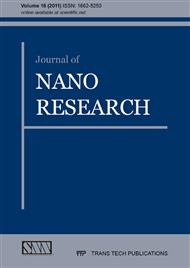[1]
M.S. Dresselhaus, G. Dresselhaus, R. Saito, Physics of Carbon Nanotubes, Carbon 33 (7) (1995) 883–91.
DOI: 10.1016/0008-6223(95)00017-8
Google Scholar
[2]
E.T. Thostenson, Z. Ren, T.W. Chou, Advances in the Science and Technology of Carbon Nanotubes and Their Composites: A Review, Compos. Sci. Technol. 61 (2001) 1899–(1912).
DOI: 10.1016/s0266-3538(01)00094-x
Google Scholar
[3]
M. Rahmandoust and A. Öchsner, Influence of Structural Imperfections and Doping on the Mechanical Properties of Single-walled Carbon Nanotubes, J. Nano Res. 6 (2009) 185–196.
DOI: 10.4028/www.scientific.net/jnanor.6.185
Google Scholar
[4]
M. Rahmandoust and A. Öchsner, On Finite Element Modeling of Single and Multi-walled Carbon Nanotubes. J. Nanosci. Nanotech. 12 (2012) in press.
DOI: 10.1166/jnn.2012.4521
Google Scholar
[5]
C. Li, T.W. Chou, A Structural Mechanics Approach for the Analysis of Carbon Nanotubes, Int. J. Solids Struct. 40 (2003) 2487–2499.
Google Scholar
[6]
C.M. Wang, Y.Y. Zhang, Y. Xiang, and J.N. Reddy, Recent Studies on Buckling of Carbon Nanotubes, Appl. Mech. Rev. 63 (2010) 030804–1–18.
Google Scholar
[7]
W.S. To Cho, Bending and Shear Moduli of Single-walled Carbon Nanotubes, Finite Elem. Anal. Des. 42 (2006) 404–413.
DOI: 10.1016/j.finel.2005.08.004
Google Scholar
[8]
S.M. Mavalizadeh, M. Rahmandoust and A. Öchsner, Numerical Investigation of the Overall Stiffness of Carbon Nanotubebased Composite Materials, J. Nano Res. 13 (2011) 47–59.
DOI: 10.4028/www.scientific.net/jnanor.13.47
Google Scholar
[9]
C.W. Fan, Y.Y. Liu and C. Hwu, Finite Element Simulation for Estimating the Mechanical Properties of Multi-walled Carbon Nanotubes, Appl. Phys. A 95 (2009) 819–831.
DOI: 10.1007/s00339-009-5080-y
Google Scholar
[10]
I. Eslami Afrooz, A. Öchsner and M. Rahmandoust, Effects of the carbon nanotube distribution on the macroscopic stiffness of composite materials, Comp. Mater. Sci. 51 (2012) 422–429.
DOI: 10.1016/j.commatsci.2011.08.003
Google Scholar
[11]
H.J. De Los Santos, Introduction to Microelectromechanical Microwave Systems, Artech House Publishers, London (1999).
Google Scholar
[12]
P.J.F. Harris, Carbon Nanotubes Composites. Maney for the institute of materials, minerals and mining and ASM international, Int. Mater. Rev. 49 (2004) 31–43.
Google Scholar
[13]
T. Irvine, Application of the Newton-Raphson Method to Vibration Problems, Vibrationdata Publications, (1999).
Google Scholar


